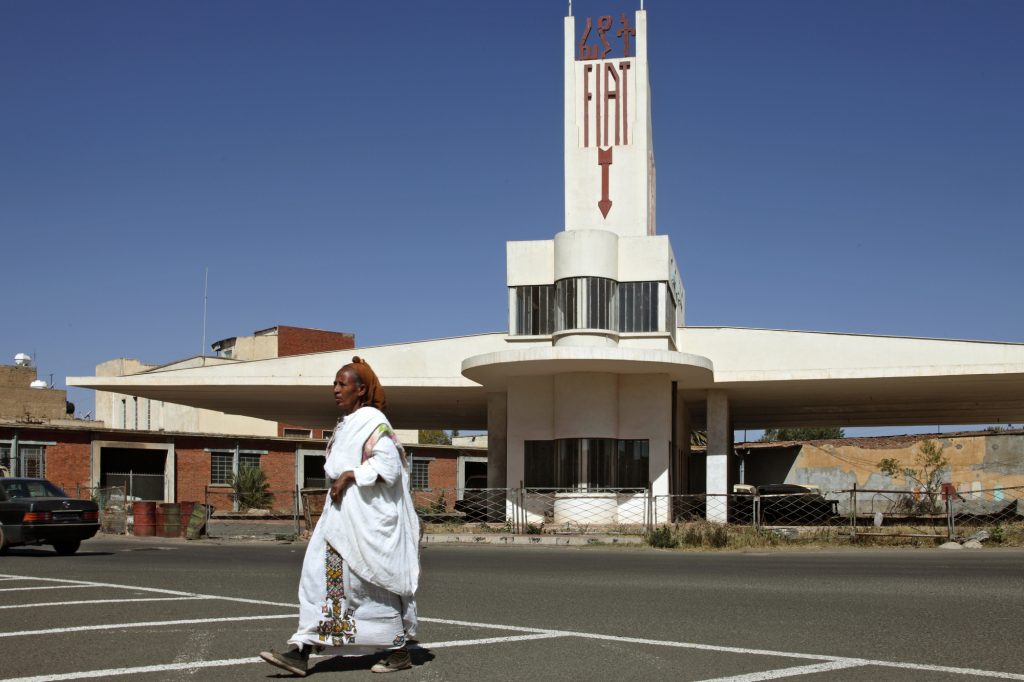Cities of Africa in Rome and the cities of Eritrea: from the past of Adulis to the Modern of Asmara, Unesco heritage.


©EritreaLive, Asmara, Fiat Tagliero
Cities of Africa in Rome and the cities of Eritrea: from the past of Adulis to the Modern of Asmara, Unesco heritage.
In recent days in Rome there has been talk of the cities of Africa, urbanization as a possible growth factor and the relationship with Italy.
A conference promoted by the Ministry of Foreign Affairs and International Cooperation, Maeci, attended by institutional representatives and delegations from many African countries.
These include Eritrea.
Mr. Angelino Alfano, Italian Minister for Foreign Affairs and International Cooperation, opened the Cities of Africa meeting, saying: “we are convinced that urbanization should not only be a social phenomenon to be observed, but also a factor of growth and prosperity “. “It is not by chance”, he continued, “that many mayors from all over the world participated in the work to define the 2030 Agenda“.
In fact point 11 of the SDGs asks cities and communities to become sustainable. This is the way to break the image of the cities of Africa made of dirt roads, villages of huts or, worse, violent shantytowns.
It is estimated that in 2030 the African urbanization rate will be of 50% and will reach 60% in 2050, when the African population will be the biggest and youngest in the planet.
United Nations sources also say that 569 million people will live in African cities, more than in Europe and Latin America.
Looking at the development of African cities is therefore a priority. The aim is to create “inclusive, safe, durable and sustainable cities” where everyone can live and work in dignity.
According to a 2016 AEO (African Economic Outlook) study, realized with the African Development Bank (AfDB), the Organization for Cooperation and Economic Development (OCSE) and the United Nations Development Program (UNDP), Africa’s urbanization may be the trigger for a “structural transformation” which will be able to make life conditions better and safer.
The driving force of this transformation are not large cities, but small towns. In fact, the majority of the population lives in medium-sized cities. 91 per cent in Eastern Africa. These are the cities that must receive the help of local administrations to become sustainable.
And Asmara, the capital of Eritrea, which was born and has always remained a people-friendly and manageable city, is already sustainable.
Asmara and Adulis were spoken about during an in-depth discussion during a meeting on African cities.
Two special cities for different reasons.
On the one hand there is Asmara, an example of Italian urban colonialism. The city was occupied by general Baldissera in 1889, and started taking its current shape under governor Ferdinando Martini (1897-1907). Today Asmara has been added to the UNESCO World Heritage sites for its very peculiar architecture and urban form.
On the other hand is Adulis, the past of Eritrea, a city still to be discovered.
These were the subjects of the meeting on 14th November at the Italian Geographic Society.
Mr. Giuseppe Mistretta, central Director for Sub-Saharan African Countries asks the crucial question: “what can Italians do for African cities?” The underlying issue being that Italy has more ideas than funds. Italy has the skills and the people, but cannot stand comparison with what has been implemented by other stronger international bodies.
The hope of Ambassador Mistretta, who until last month represented Italy in Addis Abeba, is that the Italian touch remains in African cities, even if it is a colonial legacy.
For this reason he mentions the work of Arturo Mezzedimi, architect of Heilè Selassiè, who built the Africa Hall building, among others, which hosts the headquarters of UNECA, United Nations Economic Commission for Africa.
And it is just Mezzedimi, the architect of superproduction, as he was defined, who leads us back to Asmara. In fact that is where he started his work. He arrived in Eritrea when he was young with his family. When he was still a land surveyor and before his graduation, he designed and built, between 1944 and 1945, the beautiful Piscina Mingardi. And he went on to build over a thousand social houses, for both private and public customers.
He had a modern spirit. He thought, in fact, that the architect should work on the existing reality, recovering its meaning, without revolutionizing traditions. When the Italians and the English left, Mezzedimi did not abandon Africa, widening his scope of work from Asmara to Addis Abeba in the Sixties.
Taking as a model the beauty of the city of Asmara, Mistretta closed his speech underlying that what fascinates travellers about African cities are not skyscrapers or commercial centres, but the uniqueness of their architecture. As in the case of the Fiat Tagliero station in Asmara, designed in 1938 by another Italian, Giuseppe Pettazzi.
“Strolling in the centre of Asmara”, says in this respect Ambassador Fesshazion Pietros, “is a pleasure not only for architects and experts, but also for tourists and for all of us.” It is the architectural heritage which makes this city unique and it is for this reason that Eritreans decided to safeguard and protect it, also with help from Italy.
“Cooperation with Italy” he continues “is important. We count on the Italian expertise in conservation and restoration.”
The pride of the Eritreans for their capital is even stronger today, thanks to the recognition of Unesco. A pride, that strengthens the bond with Italy, looking beyond colonialism, to keep the friendship between these two people alive, says the Ambassador.
“Colonialism”, leaving aside inappropriate historical revisions, “realized buildings and infrastructures in Eritrea. It was not only invaders who arrived, but also architects, engineers, urbanists. People who built a modern city” explained Ambassador Fesshazion.
And this modernity is what makes the beauty of Asmara.
A city that is not only beautiful, but lucky, too. Asmara was saved from Ethiopian bombings until the end. So it reached the day of its liberation in 1991 without suffering major damage.
Once they conquered independence, the Eritreans decided that their capital had to be restored, to keep it at its best. Just like a precious jewel.
In 1991 the Department for Urban Planning and Development, and afterwards the DUD, Department for Urban Development were born. Projects for all the cities in the country were made, including those that had been heavily bombed like Nafka and Massawa.
It was, however decided to start from Asmara. The capital needed new sewage and water networks for its inhabitants, after years of neglect.
So from 1991 to 1998, before the conflict with Ethiopia, numerous projects were started for the conservation and restoration of existing buildings. Then war (1998-2000) stopped such initiatives.
In 1997 the CARP, Cultural Assets Rehabilitation Project was born, an agreement between the Eritrean Government and the World Bank to establish the correct manners for reconstructions. An activity, which also aimed at helping economic recovery and fighting poverty. Among the initial CARP projects were the restoration of the Capitol Cinema and the Theatre of Asmara. Both projects were resumed, twenty years afterwards, by the Asmara Heritage Project (AHP).
And it was just the Asmara Heritage Project, coordinated by Engineer Medhanie Teklemariam, which led Asmara first to the candidacy, and then to the prestigious recognition by Unesco.
The current project, as did previous ones, aims to preserve not only the architectural heritage but also the Country’s culture, traditions and history. Among the sites that will be proposed to Unesco in the future there are, in fact, archeological sites like Koaito, Metera, Adulis, the ancient Mosque of Massawa and monasteries.
The work that led to the nomination for Asmara, explains Mr. Medhanie, is collated in a file of 1,300 pages and is the result of a multi-disciplinary approach, with the cooperation of experts in different fields, apart from engineers and architects, of course.
“The goal” he says “was not only that Asmara would become a Unesco World Heritage site, but also that there would be a complete and thorough knowledge of the city. For this purpose more than 4,000 buildings were inventoried. Asmara is lucky enough to have inherited a precious archive, with detailed documents, drawings and original projects. Necessary material to trace the history of each building.”
The AHP tried, during the works, to involve the inhabitants, explaining the projects and future interventions.
All this not only for theoretical reasons, but also for the impact the new guidelines for restoration and preservation will have in the city centre. We must, in fact, remember that the last town plan of Asmara dates back to 1938 and future changes must take into account the needs of people in the XXI century, without upsetting the past. A tough challenge.
The first intervention involves the historical perimeter of the city centre and buildings until 1941. A work that highlights the legacy of Italian planners and architects.
Some buildings, explains Medhanie, are the evident result of the union of tradition with modernity. For instance, the Enda Mariam Coptic Cathedral, with the fusion of local elements for a project similar to the one realized in 1934 by Marcello Piacentini for the Church of Cristo Re in Rome.
One of the indications, which has arisen from the speeches of African mayors is that projects for African cities must respect local traditions and culture.
Finally, Medhanie stresses that Asmara’s proclamation as Unesco site involves advantages, first of all for tourism, but also responsibilities, because, from now on the site will attract the world’s attention .
For this reason the 2016-2020 plan was approved to start projects for the urban and architectural conservation and restoration.
Another point, which was touched upon in the in-depth discussions during the conference at the Italian Ministry of Foreign Affairs is the security of the cities. A goal which Asmara has reached and maintains. Even if it is divided in zones by the colonial city plans, it has not suffered major divisions between centre and suburbs.

©EritreaLive, Roma, cities of Africa, conference on Eritrean cities, the past is Adulis, the present is Asmara, Unesco World Heritage Site
It is a city without informal settlements. There is no ethnic or religious segregation. Besides, women participate in the administration of the city, another important point indicated during the conference.
Architect Susanna Bortolotto (Polytechnic of Milan),who will start the new excavations campaign in January (she’s looking forward to it!) together with the archeologists of the Italian-Eritrean mission, said that she is enthusiastic about working in Eritrea, about the contact with local people and institutions in an interview to Shabait .
Her experience in Eritrea begun in 2012 to happily reach the Unesco goal, of which you can tell she is proud as a godmother. In the beginning she worked with the team of Pompei, Alfredo and Angelo Castiglioni (CeRDO), for the excavations and rediscovery of the ancient city on the Red Sea, Adulis. An African 40 hectares to be explored digging with tenacity to bring a disappeared civilization back to light.
Afterwards, for the Italian architect came the – almost mandatory step – from the excavations of Adulis to the old town plans of Asmara.
Susanna Bortolotto says: “I went from Adulis aksumite archeology to modern archeology” that of Asmara. Where, meeting Medhanie and joining forces and expertise, the Unesco nomination also arrived.
Now the new work starts. On the one hand conservation and restoration of the city, on the other hand on-site training for the people involved. This will be taken care of by the Polytechnic of Milan with a course on architectural and urban restoration methods and on conservation procedures of Modern buildings.
This is another point in favour of Italy. A cooperation in line with the intentions of the Italian Ministry of Foreign Affairs.
To preserve the Asmara Style, explains the architect, apart from the necessary knowledge of the materials, the original colour of the buildings must be maintained. “the Rationalism, which in Italy expressed itself with white” she continues “uses colours in Asmara, because white would not make sense with its strong brightness and because the earth blown by the wind would soon soil it.”
Therefore yellow, ochre, brown, red colours are chosen and all their nuances which made the city so beautiful.
Eritrean quarters are far from the dangers of shanty towns. A danger, which according to UN-Habitat, many Africa Countries may incur. By 2050 according to the report there will be many people moving from the countryside to the cities. A situation that will triple the slum population, according to the study.
Finally an excursus on the ancient city of Adulis. Archeologist Serena Massa from the Milan Cattolica University talks about it.
Like Pompeii, Adulis, she says, is a city that has been betrayed, rather than by fire, by water. It disappeared towards the VII century AD was buried under meters of mud, for a violent flood. It was an important and rich city. A commercial and cultural crossroads between East and West.
The Italian-Eritrean mission that works for its rediscovery began in 2011. Thanks to CeRDO and the contribution of several Italian universities, including the Orientale of Naples.
The city had already been identified by some previous missions, up to the early twentieth century mission of the Italian archaeologist, Roberto Paribeni. But then it was again abandoned to the sand and silt.
At the moment only a very small part of the ancient Adulis has been brought to light. Findings that tell the daily life, houses, shops, coins, churches.
One of the three churches is the one that Paribeni called “Ara del Sole”. In fact, these churches built in the second half of the fourth century AD could be the oldest evidence of Christianity in the area of the Horn of Africa.
The story would therefore say that Adulis, who was part of the reign of Aksum, was a Christian city. News that has aroused the interest of the Pontifical Institute of Christian Archeology.
The charm of the story of Adulis’ mission will continue next January 2018.
For those who, while remaining in Italy, wanted to see a glimpse of Adulis, the lost city, meeting the fragments and testimonies, the advice is to visit the beautiful exhibition of Varese, at Villa Toeplitz, at the Museo Castiglioni. .
©Marilena Dolce




Lascia un commento